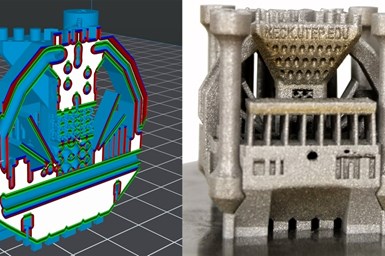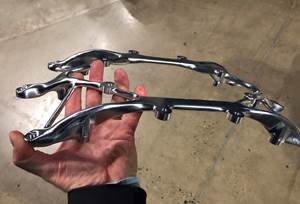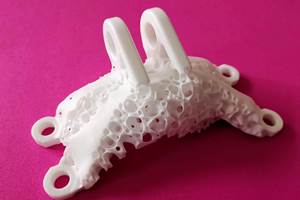Dyndrite Collaborates With AMFG for Cross-Platform 3D Metal Automated Production
AMFG powered by Dyndrite is an integrated solution that is said to unlock the full potential of metal 3D printing by bringing order-to-part automation, eliminating bottlenecks and streamlining the entire production process for increased efficiency and cost savings.

Dyndrite's software is said to give LPBF materials, part/process and applications engineers power and control over their geometry, build specific toolpathing and laser parameters. Photo Credit: Dyndrite
Dyndrite is partnering with AMFG to offer AMFG powered by Dyndrite, a software solution that brings an integrated solution to both streamline and automate metal AM production. The solution combines Dyndrite’s GPU-accelerated computation engine used to create digital manufacturing hardware and software with AMFG’s MES and workflow software for managing manufacturing workflows.
This integrated solution is said to unlock the full potential of metal 3D printing by bringing order-to-part automation, eliminating bottlenecks and streamlining the entire production process for increased efficiency and cost savings.
Additive CAM, also known as 3D print preparation, often remains a manual, time-consuming and tedious roadblock to a truly autonomous manufacturing workflow. This is especially true where machines from multiple vendors are involved or where different customer orders must be collated into the same build.
AMFG powered by Dyndrite combines advanced order processing capabilities with the industrial 3D printer processing capabilities of Dyndrite. The combined solution enables laser powder bed fusion (LPBF) users and service bureaus to deploy automated ordering, collating and dynamically processed part production services. In addition, customers can drive cross-platform LPBF printing from one application and experience hundreds of hours of labor reduction per year.
The companies say an investigation among AMFG customers reveals impressive benefits from the program. This includes saving more than 500 hours in labor per machine per year for powder-based processes alone. Additional advantages include minimized human error, expedited turnaround times and enhanced machine utilization. Monthly, this translates to 220-300 hours saved for six machines, which equates to approximately 40 hours per printer per month. The integration of AMFG with Dyndrite not only streamlines the manufacturing process but can also significantly impact businesses by facilitating quicker time to market and fostering trust through the reduction of time to ship.
“Our partnership with AMFG allows us to stay at the forefront of the Additive Industry. We are excited to further streamline the production process through automated print preparation, allowing us to deliver high-quality parts to our customers faster than ever before,” says Richard Minifie, Ricoh senior additive manufacturing engineer. “This has not only helped us improve our customer satisfaction but also deepened our relationship with Dyndrite, as we work together to explore new opportunities enabled by a true automated additive CAM solution.”
It is said the ability to deploy automated LPBF additive CAM solutions revolutionizes its applicability as a reliable AM production process. The combination of AMFG and Dyndrite transforms the technology from a promising but cumbersome concept to a practical and reliable manufacturing tool.
Preparing build files for additive manufacturing processes, including LPBF, can be a complex and time-consuming process, often taking days or weeks to complete. This problem is compounded when working with multiple machines from different vendors as each machine often has its own proprietary method for driving the process. The lack of standardization of file formats, parameters and protocols also means engineers and technicians must spend more time adjusting and tweaking build files. With the challenges of the skills shortage across manufacturing, it has become more difficult to train and retain technicians with technical proficiency across multiple machine and software standards. This is all without considering the cost of paying numerous legacy software licenses and modules to manually prepare build files. These issues are especially acute for service bureaus that work across multiple platforms and require streamlined part production and managed labor costs.
AMFG powered by Dyndrite, provides an autonomous manufacturing workflow. The benefits of each software complement each other to form a unified solution include AMFG’s order management system which receives and collates orders from multiple customers, sorted by machining process and parameters. Next, the disparate parts enter AMFG software powered by Dyndrite, whose GPU-accelerated CAM engine enables those parts to be nested, supported, labeled and toolpaths generated for compatible machines, including Aconity3D, EOS, Renishaw, SLM Solutions and others.
Next, production build data reenters AMFG’s MES, which harnesses its production planning capabilities to provide real-time build status updates and analytics, as well as its QMS to ensure jobs are completed with no compromise in quality. The AMFG MES powered by Dyndrite eliminates countless engineering hours spent manually prepping and collating build files and acquiring costly software modules for each metal platform acquired.
The solution also enables automated process-to-part capability from one application for cross-platform LPBF printing via bidirectional data exchange between MES and ToolPath generation app.
"We are entering a new era of manufacturing. One driven by data and automation,” says Keyvan Karimi, AMFG founder and CEO. “By adopting Dyndrite, we enable data automation down to the toolpath, unlocking the full potential of each machine, while growing efficiency and reducing the potential for human errors. Dyndrite’s cutting-edge technology is enabling our LPBF customers to produce complex parts with unprecedented precision, speed and reliability, giving our industry the boost it needs to compete with traditional manufacturing techniques."
The partnership between AMFG and Dyndrite is said to mark a significant step toward a seamless production process for 3D metal machines. “By combining the strengths of our respective software, we’ve created a one-stop-shop solution that streamlines the complex and time-consuming task of driving the AM process,” says Harshil Goel, Dyndrite founder and CEO. “With AMFG using our engine, manufacturers can expect increased efficiency, consistency and reliability, making LPBF a more practical and adoptable tool in their production process.”
- Read about Dyndrite’s collaboration with Novanta to enhance laser-based AM metal printing machine capabilities.
- Learn more about Dyndrite’s end-user software which expands development for LPBF machines. The system supports multioptic build strategy operations and laser parameter control limited only by vendor openness.
- Check out this article about Dyndrite’s partnership with SLM Solutions to maximize digital manufacturing software tools. The companies are working together to enable users to fully create SLM parameters and tool paths to fit their individual needs, maximizing materials development and application or part-specific build rate strategies.
Related Content
3D Printed Cutting Tool for Large Transmission Part: The Cool Parts Show Bonus
A boring tool that was once 30 kg challenged the performance of the machining center using it. The replacement tool is 11.5 kg, and more efficient as well, thanks to generative design.
Read MoreLightweight Components: A Paradox When Machining
Today’s computer software can just as easily generate lightweight shapes for subtractive processes as it can for additive ones, but it increases cost and waste to make them.
Read MoreActivArmor Casts and Splints Are Shifting to Point-of-Care 3D Printing
ActivArmor offers individualized, 3D printed casts and splints for various diagnoses. The company is in the process of shifting to point-of-care printing and aims to promote positive healing outcomes and improved hygienics with customized support devices.
Read MoreSpherene Creates Metamaterial with Geometry Derived from Spheres
An algorithm developed by Spherene Inc. generates Adaptive Density Minimal Surfaces (ADMS) as a self-supporting infill strategy that can be used to reduce mass and manage material properties in 3D printed parts.
Read MoreRead Next
To Improve Performance of Compression Molded Composites, Add 3D Printed Preforms
9T Labs' Additive Fusion Technology enables the manufacture of composite structures with as much or as little reinforcement as is necessary, using 3D printed continuous fiber preforms to add strength just where needed.
Read MoreVideo: Intelligent Layering Metal 3D Printing at 3DEO
Contract manufacturer 3DEO delivers metal parts using Intelligent Layering, a binder jetting-like 3D printing process the company developed and operates internally. Here’s how it works.
Read MoreLooking to Secure the Supply Chain for Castings? Don't Overlook 3D Printed Sand Cores and Molds
Concerns about casting lead times and costs have many OEMs looking to 3D print parts directly in metal. But don’t overlook the advantages of 3D printed sand cores and molds applied for conventional metal casting, says Humtown leader.
Read More









.png;maxWidth=300;quality=90)













